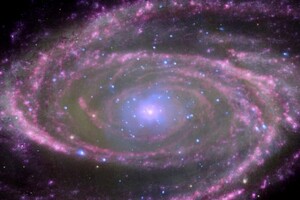This is probably one of 100 thousand wandering black holes in our galaxy.

A group of scientists from the University of California at Berkeley said the fact that the black hole-exile, who wanders alone in the Milky Way, may be the smallest known at the moment. This is indicated by new measurements of its mass, conducted by researchers, according to Space.com.
Earlier this year, astronomers announced the discovery of the first known wandering black hole in the star mass. It is located five thousand light years from Earth, it was discovered due to the force of its gravity, which acts as a gravitational lens, increasing the light of the star behind it, at a distance of 19 thousand light years from us.
Read also: Astronomers questioned the accuracy of the first images of the black hole
Initially, a black hole was detected using ground-based telescopes. Kailash Sakha's team at the Hubble Space Telescope Institute then used additional observations of the object with the Hubble Space Telescope and concluded that the mass of a black hole is about 7.1 times the mass of the Sun.
But new research conducted by American scientists has shown that the mass of a black hole is actually 1.6-4.4 solar. If these conclusions are confirmed, they could have intriguing consequences.
Black holes in stellar mass appear as a result of supernova explosions with a mass 20 times greater than that of the Sun. If stars with a mass of eight to 20 solar stars explode supernovae, they turn into neutron stars.
The mass of neutron stars, in theory, can be up to 2.3 masses of the Sun. Observations of binary systems did not reveal black holes with masses less than five solar. This creates a gap between the most powerful neutron stars and the smallest black holes.
“Whatever it is, this object is the first detected remnant of a dark star that roams the galaxy unaccompanied by another star,” said the lead author. Casey Lam's study.
Stars with a mass of more than 20 solar cells make up only 0.1% of all the stars in the Milky Way. But there are so many stars in our galaxy (about 100-200 billion), and it is so old (about 13 billion years) that there must now be about 100 million or more black holes in the Milky Way.
Many of them are in dual systems, where their presence is evident due to gravitational attraction to the companion star and the accretion of material from a neighbor. One such black hole was discovered inside the NGC 1850 star cluster in the Large Magellanic Cloud. But many other similar objects roam between the stars, remaining unnoticed until a random combination with the background star creates a gravitational lens, which is discovered by scientists.
Earlier astronomers used a very large telescope to find six galaxies surrounding a supermassive black hole . The discovery will allow scientists to understand how supermassive black holes could form and reach colossal proportions in a short time.




